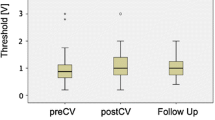Background:
Previous studies showed that internal cardioversion (intCV) of atrial fibrillation (AF) is feasible. Aim of the present study was to compile initial feasibility data examining the safety and efficacy of a new device for intCV of chronic AF with an additional option for atrial and ventricular back-up pacing. Methods: IntCV of AF (duration of AF: 14±18 months) was performed in 27 patients (pts, age: 57±10y, 6 pts with implanted pacemaker, 7 pts after open heart surgery). A single lead balloon guided 7.5 french catheter for intCV (EP MedSystem) was introduced via a brachial vein. The distal shock array was placed in the left pulmonary artery, the proximal shock array was positioned to make contact with basal atrial tissue. Hemodynamic measurements were performed via the center lumen with an opening at the distal tip. R-wave triggered biphasic shocks of 50% tilt were delivered by the new external defibrillator (Alert, EP MedSystem) device that incorporates combined 12 lead surface ECG, intraatrial, and ventricular EGM online recording and monitoring on an integrated LCD monitor and printer. The option of atrial (AAI, AOO) stimulation for overdrive suppression of atrial premature beats after intCV and ventricular (VVI, VOO) pacing for postshock bradycardia can both performed by the new device. Results: 25/27 pts (93%) were successfully cardioverted to stable sinus rhythm, the mean energy requirement was 6.7±4.5J. Triggering of the cardioversion shock to the internally sensed R-wave was accurate with all shock applications. In 5 pts atrial post shock pacing was performed for overdrive suppression of atrial premature beats. The mean fluoroscopy time was 2.0±1.3min. Conclusion: IntCV of AF by the means of this new device proofed to be safe, effective, and easily performable. Especially patients resistant to external cardioversion, patients with implanted pacemakers, and post cardiac surgery pts might benefit from use of this system with the option of internal cardioversion, AAI and VVI pacing, and implant performance similar to a conventional Swan Ganz catheter.
Hintergrund:
In bisher veröffentlichten Studien konnte gezeigt werden, daß die interne Kardioversion (intCV) bei Vorhofflimmern (AF) mit hohen Erfolgsraten durchführbar ist. Ziel dieser Studie war es die Sicherheit und Effektivität eines neuen Systems zur intCV zu prüfen. Methoden: 27 Patienten (pts; Alter: 57±10 Jahre, 6 Schrittmacherpatienten, 7 Patienten nach herzchirurgischen Eingriffen) mit AF (Dauer: 14±18 Monate) wurden intern kardiovertiert. Ein neuer 7,5F Einschwemmkatheter (EP MedSystem) wurde über die Vena brachialis mit den distalen Schockelektroden in der Arteria pulmonalis sinistra und den proximalen Schockelektroden im rechten Atrium positioniert. Ein distales Lumen erlaubt die Messung hämodynamischer Parameter. Über einen neu entwickelten externen Defibrillator (Alert, EP MedSystem) mit integriertem LCD Bildschirm, zur Registrierung und Speicherung von Oberflächen EKGs und intrakardialen Signalen, wurden R-Wellen getriggerte Schocks mit 50% Tilt abgegeben. Optional konnte intrakardial im Sinne einer Überstimulation von Extrasystolen oder Bradykardien nach erfolgreicher intCV atrial oder ventrikulär stimuliert werden. Ergebnisse: 25 der 27 Patienten (93%) konnte mit einer mittleren Energie von 6,7±4,5J erfolgreich zu Sinusrhythmus kardiovertiert werden. Die R-Wellentriggerung über den externen Defibrillator war bei allen Schockabgaben sicher. Schlußfolgerung: Diese initiale Machbarkeitsstudie legt nahe, daß die intCV von AF mit dem neuen System sicher, effectiv und einfach durchzuführen ist. Insbesondere Patienten nach erfolglosem externem Kardioversionsversuch, Patienten mit implantierten Schrittmachern und Patienten nach herzchirurgischen Eingriffen könnten von einem Einsatz des neuen Systems profitieren, was in weitergehenden Studien noch genauer untersucht werden sollte.
Similar content being viewed by others
Author information
Authors and Affiliations
Additional information
Eingegangen: 28. Februar 1998 Akzeptiert: 9. März 1998
Rights and permissions
About this article
Cite this article
Plewan, A., Valina, C., Koller, B. et al. Erste Erfahrungen mit einem neuen System zur internen Kardioversion bei Vorhofflimmern. Herzschr Elektrophys 9, 88–93 (1998). https://doi.org/10.1007/s003990050016
Issue Date:
DOI: https://doi.org/10.1007/s003990050016




